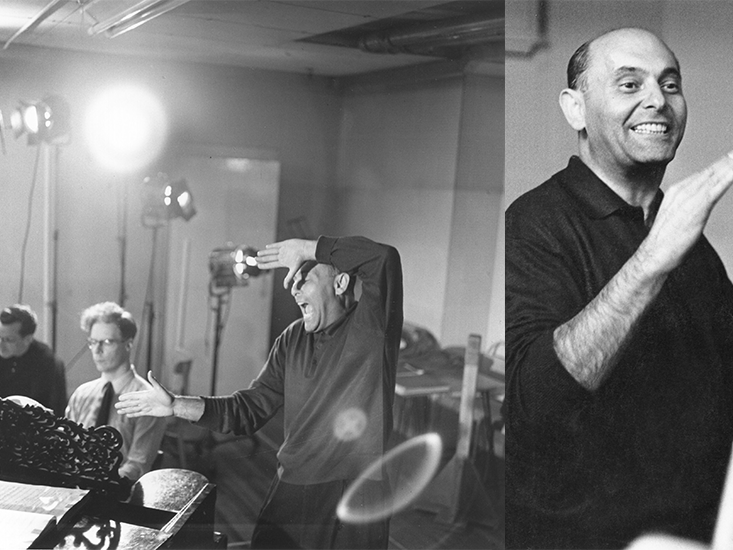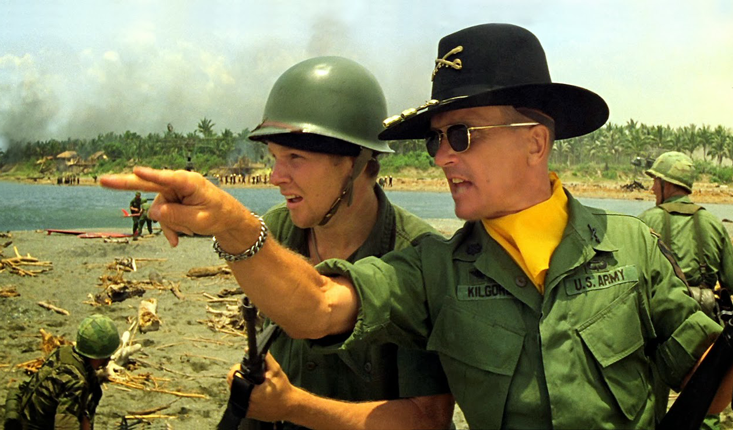In 1979, sometime during the barely controlled chaos of the last months of finishing Francis Ford Coppola’s Apocalypse Now, someone in legal affairs had the presence of mind to ask if we had secured the rights to use the 1965 Georg Solti recording of the “Ride of the Valkyries,” the music which accompanied Colonel Kilgore’s attack on the Vietnamese village of Vin Drin Dop, otherwise known as Charlie’s Point.
The idea of blasting music from Wagner’s opera Die Walküre as a form of PsyWarOp (Psychological Warfare Operations) to terrify the Vietnamese had originated deep in the neuronal labyrinth of John Milius’s mind in 1969, when he was writing the original screenplay for Apocalypse Now.
“That Valkyrie scene came from a vision I had of the exhilaration of war—right alongside the terror and the horror and the fear of being snuffed out. The glory of it!” John told Lawrence Weschler in a 2005 Harper’s article. “Nowadays—unlike during the Victorian era when the glory was all that got discussed—nowadays it’s the horror that always gets talked about. And either one by itself, of course, is a ridiculous half-statement.”
The “Ride of the Valkyries” was so deeply associated with the attack on Charlie’s Point, and had been for so long—from birth, so to speak—that we who were working on the film, editing the picture and mixing the sound, could barely conceive of separating the two. How that particular Solti recording came to be chosen, I never found out—the decision predated my joining the film—but there is a general consensus in musical circles that Solti’s interpretation, conducting the Vienna Philharmonic, has never been surpassed.
So it came as an existential shock when Decca, the record company in question, said firmly: No.
There was so little time left that we were constrained to move forward along three fronts, hoping that at least one would pay off: 1) to continue to petition Decca; 2) to make arrangements to record the “Valkyries” with the San Francisco Symphony, trying to duplicate Solti’s dynamics and meter; and 3) to comb through all the existing recordings with the hope of finding one that was close to Solti’s interpretation and available to use in the film.
The last of these approaches fell to me, since I was responsible for the sound design of the film as a whole, as well as being, at that time, the picture editor for this section of the film.
The problem with many of the versions of “Valkyries” that I rejected was they were monotonously rhythmic: The result was a robotic stagger, a simulation of musical life rather than the real thing.
This was of course long before iTunes—the Apple II had only been recently released and the Macintosh was not yet gleaming in Steve Jobs’s eye—so our database of necessity was the Schwann catalogue of recorded music.
It turned out that there were 19 stereo recordings of “The Ride” available in 1979, and I bought them all from Tower Records at the corner of Bay and Columbus in San Francisco.
It was the musical equivalent of ransacking every bottle of burgundy—Gallo to Romanée-Conti—from the nearest wine shop. But as soon as I uncorked many of them, nestling the needle into the grooves of the LP, I knew that they wouldn’t work: There was a vinegary tang to them—certainly in comparison to the Solti—that made my eyes water.
But a number of the others, perhaps half, deserved more serious consideration. How serious I was soon to discover.
There is a complex rhythmic relationship in film between the visual action on screen and the music, whatever it might be. And during the editing of the film that relationship is constantly being adjusted and tightened, sometimes consciously, other times on a more intuitive basis.
But that same complex relationship also takes place in the performance of the music itself, as the conductor balances, on a moment-by-moment basis, the rhythmic signature of the score, adjusting it to his interpretation and the particular strengths (and sometimes, weaknesses) of the orchestra he is leading.

The greatest conductors and orchestras, and Solti and the Vienna Philharmonic were certainly in that group, are able to shape these minute adjustments to the rhythmic signature so closely that they are perceived as regular but in fact are not, thus enhancing the organic, living and breathing nature of the music itself. The problem with many of the versions of “Valkyries” that I rejected was that they were monotonously rhythmic: A metronomic signature had been decided upon and stuck to, regardless of circumstance. The result was a robotic stagger, a simulation of musical life rather than the real thing.
This is reflected in our intimate relationship with the rhythms of our own bodies, their heartbeat and breathing. We may think that most of the time our heartbeat is regular, but in fact it is not. It is constantly being micro (and sometimes macro) adjusted on a beat-to-beat basis, responding to neurological feedback between the heart, the brain, and the needs of the body for oxygenated blood. And the same applies to our rate of breathing, which is intimately related to our circulatory system.
The medical term for a healthy but slightly irregular rhythm is “ectopic,” and it is our largely unconscious awareness of this dynamic pulse which reminds us that we are alive. In cases of medical emergency, that closely monitored feedback between the heart and the needs of the body is often weakened or severed, and a machine-like regularity of heartbeat appears, signaling trouble or impending death.
Similarly, music that lacks this dynamic, quicksilver pulse is perceived, consciously or not, as lacking an essential spark of life.
Solti’s conducting of the “Valkyries” was instead a sublime example of what we might call ectopic music—a powerful embodiment of the living, pulsing heart and breath of Wagner’s composition.
When we had bound Solti’s “Valkyries” to that scene in Apocalypse, the DNA of both of music and film had become inextricably linked on the largest thematic levels—remember that the Valkyries themselves are god-like female virgins riding winged horses carrying the bodies of battle-slaughtered soldiers to Valhalla—as well as the miniscule metrics of film-frame and semiquaver.
But as great as Wagner’s music is, and as wonderful as Solti’s recording is, we had taken a number of liberties.
We had made a cut, after about 45 seconds, when the action suddenly shifts to the Vietnamese school and there is a shocking momentary silence, soon intruded upon by the distant sound of helicopters and the faint wafting of the music borne on the froth of whirring blades.
This builds in intensity as the Air Cav gets closer, the teachers and students in the school begin to panic, and then the voices of the Valkyries are heard for the first time over a long shot of the helicopters, just specks on the horizon, with surf breaking in the foreground.
Whenever I watch the film, the chemistry of music and image in the next section always strikes me as particularly miraculous: the shot of the helicopters from behind as they approach the beach, the Vietnamese soldiers running along their elevated walkways, jumping into trenches, and then a remarkable series of moving shots of the helicopters, the singing Valkyrie accentuating each cut, building in intensity until the beach is crested and the first shots are finally fired.
There is a second cut in the music during a close shot of the muzzle of a mini-gun blasting its thousands of rounds a minute, and we reprise the previous section with the Valkyries vocal, although in a somewhat abbreviated form.
We dropped the whole middle section of Wagner’s original, where the Valkyries are calling out to each other: “Here Helmwige, bring your horse here—Put your stallion next to Orlinde’s mare, your bay will enjoy grazing with my gray—Who is hanging from your saddle?”
If we had included this, there would have been confusion along with a massive drop in energy. Instead, we take a break in the music for about 50 seconds to concentrate on dialogue between Kilgore and his men.
Then as the helicopters begin to land on the beach, with the Marines jumping out under heavy Vietnamese fire, the “Ride” starts up again, this time with the powerful final section. When some secondary ordinance explodes, knocking the legs out from under one of the marines, the music comes to an end.
So my task, desperately crucial given our dilemma, was to find another recording of the “Valkyries” as close as possible to the rhythmic signatures of Solti’s 1965 recording, that would also allow itself to be restructured in this way. I worked out a graph of the variations Solti’s rhythm, in 4-second increments, and with a stopwatch did the best I could to take the ectopic pulse of his music. It was a fantastic crash course in musicology, revealing like an X-ray the “Ride’s” hidden twists and turns, hesitations and accelerations.
I applied the same technique to the other recordings, hoping to find a rhythm as near as possible to Solti’s. Recording after recording fell by the wayside, and in the end only one other “Valkyries” came close: Erich Leinsdorf’s 1977 recording with the Los Angeles Philharmonic.

I made a transfer from Leinsdorf’s LP to 35mm magnetic film (this was in the days when we were working with physical film, unlike today’s digital smorgasbord) and lined up the picture with the moment that Kilgore orders the PsyWarOp to begin, pushed the “play” button on my KEM editing machine, and hoped for the best.
As I watched the film, the images jostled together with this new music in their familiar way. The ectopic rhythms were holding, and perhaps this delicate organ transplant was going to work after all. I smiled along with Kilgore as the trumpets blared. Then suddenly …
I stopped the machine, disoriented. There was something wrong with the image. There had always been a peculiarly wonderful strength and acidity to the blue of the ocean that had now disappeared. I asked my assistant, Steve Semel, if he had changed the print for some reason. No, he hadn’t.
The problem turned out to be a classic case of synesthesia. At that point in the film—about 35 seconds from the start of the music—there are a series of shots featuring portraits of soldiers going into battle, the first one a down-angle shot of a rocket with the hand of marine caressing its breast, so to speak. In each of the shots the ocean is spread widely in the background.
Although Leinsdorf’s performance of the “Valkyries” was rhythmically in synch with Solti’s, at this moment Leinsdorf had emphasized the strings in his orchestral balance, whereas at that same point Solti had chosen to emphasize the brasses, which—I realized now only in retrospect—were responsible for synergizing that wonderful acid blue of the ocean. In Leinsdorf’s recording, the strings were soft and pillowy, and as a result the blue looked dead: The chemistry of the image and sound worked against each other to the detriment of both. I turned off the machine and abandoned the search, letting Francis know the sad result. He understood the problem.
As it turned out, Francis was able to get past Decca’s gatekeepers and talk to Solti himself in Chicago. Solti responded as one maestro to another, sympathizing with the artistic predicament Francis faced: “Of course, dear boy, why didn’t you talk to me in the first place?”
The permission to use Solti’s “Valkyries” came through so late in the process, however, that we were not able to get hold of the magnetic masters in time, and what you hear in the film is a tape transfer from the LP disk, spread in re-recording to six channels of sound. But perhaps this contingency lends a certain serendipitous truth to the scene, since Kilgore himself, now revealed to be a connoisseur of music, would doubtless have also made his tape directly, as we did, from Solti’s Decca disk.
Walter Murch is a film editor, sound designer, writer, and director who has been working in motion pictures for 50 years. His credits include THX-1138, all three films in The Godfather series, The Conversation, Return to Oz, The Unbearable Lightness of Being, The English Patient, and Tomorrowland. His other interests include astronomy, beekeeping, and translating Curzio Malaparte. He is the author of In the Blink of an Eye, on film editing.























